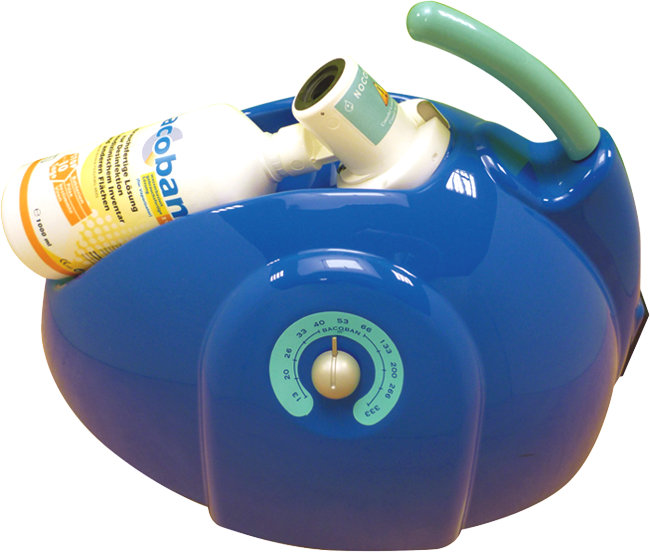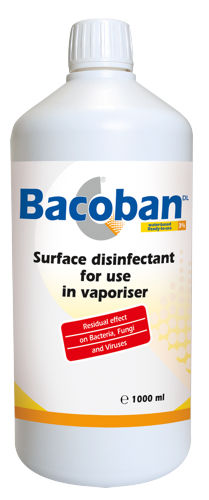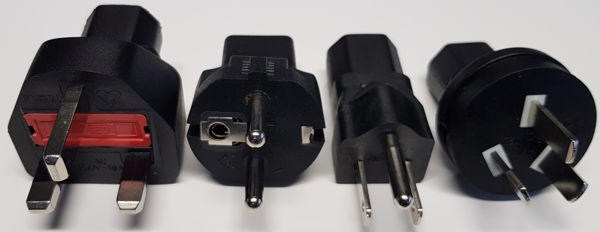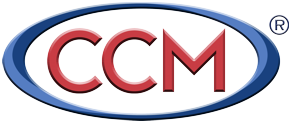Vaporizer - Nebuliser
Bacoban® surface disinfection: even, comprehensive, reliable, sustained effect
The Bacoban® nebuliser makes use of a heating and ionising turbine to nebulise the Bacoban® DL 3 %, a disinfectant verified as having long-term efficacy.
The particle size (5º on average) of this waterbased 3% ready-to-use solution precipitates evenly in densely cross-linking dry fog across every square centimetre of the room being treated.
Because no moisture is produced in this process, no sensitive objects need to be moved out of the way (suitable for rooms up to 333 m³).
Easy to use
- Place the nebuliser, which weighs only 5 kg, into the room to be treated
- Simply screw Bacoban DL 3 % in the 1000 ml bottle into the attachment
- Determine the volume of the room to be treated (L x W x H)
- Set the determined volume with the selection switch
- Press the on/off switch
- Leave the room
- Device switches off automatically

Downloads & Videos
- "About Etihad Airways using Bacoban"
- "Bacoban Nebulizer - How to use"
- "Bacoban"
- "Coating and disinfection in a gym"
- "DEXAN - Flächendesinfektion"
- "Bacoban Long Term Surface Disinfection"
- "Hygiene rund ums Tier"
- "Bacoban Long Term Disinfection on Mobile Phones"
- "ATM Machine with Bacoban alcohol based long-term disinfection"
- "Bacoban - Desinfecção com alta tecnologia" (Portugese)

Ideal for
- Hospitals
- Clinics
- Doctor's surgeries
- Laboratories
- Ambulances
- Rescue services
- Retirement homes
- Rehab centres
- Thalasso therapy centres
- Saunas
- Spa and bathing facilities

Power plugs included
Frequently Asked Questions (FAQ)
Fogging is similar to spraying. A liquid is propelled from of a nozzle. The liquid leaves the nozzle as a droplet. The droplet can range in size but most foggers work in the 20 to 50 micron size droplet range.
The droplet travels for a short distance before the weight of the droplet causes the droplet to fall to the ground. The larger the droplet the faster the rate of descent.
When the droplet arrives at the surface it will leave a moist layer. The degree of moister relates to the make up of the solution, the output of the device, the proximity of the device to the surface and droplet size.
Fogging is an efficient mechanism for applying sanitizers to a wide range of environments but one should note that this application method is not recommended for areas where sensitive electronics are housed e.g. operating theatres, High dependency rooms in Hospitals, aircraft etc. The reason being that fogging deposits a wet film on surfaces and possibly inside these sensitive devices.
It is also important to note that fogging does not provide total encapsulation of the target surface, even when electrostatic fogging is used (although electrostatic fogging is more effective in this manner than standard fogging.) The area which has been fogged is ready for use within approximately 10 minutes.
Fogging is faster, it requires human application (in most instances) and more sanitiser is used.
Nebulising (also known as dry fogging/misting) distributes a droplet of approximately 5 microns and below.
These very small droplets spend much longer in the air and drift amount the environment until they arrive on the target surface. As a result almost all areas of the environment are coated. The droplet arrives at the surface as almost completely dry and so if it enters into electronics it will not cause any damage through excessive moisture, therefore it is recommended as a better alternative to fogging in certain environments.
Nebulising is managed using an automatic machine, it uses less liquid per m³. The length of time between nebulising and re entering the target environment is longer as it takes longer for the droplets to drop on to the surfaces within the environment (approximately 30 minutes).
Our nebulizer does not have a special unit for heating the liquid and does not generate ions.
It is not necessary to increase the temperature during the process.
As already noted the units which we recommend and supply are CE approved units which do not function using heat or ionization turbines and so we can't compare them to such units. There are hundreds of other units available and it is not possible to compare all units to our own unit. We rely on the test data which confirms the high performance of the units which we supply when being used to disperse the technology which we supply.
The unit can sanitise an area of up to 500m³ but the unit is designed to function with a 1 liter bottle which is only suitable for 330m³. In order to sanitise n area of 500m³, we recommend the use of two nebulizers. If you use this process you don't have the problem with the limiting factor of the 1 litre bottle. Alternatively you can run the machine until the bottle is empty and then the operator can enter the room, refill the bottle with the recommended amount of liquid and complete the process until the 500m³ has been sanitised. It is important to note that appropriate PPE equipment must be used if entering a room before the full dispersion and settling of the sanitizing agents has been established.
